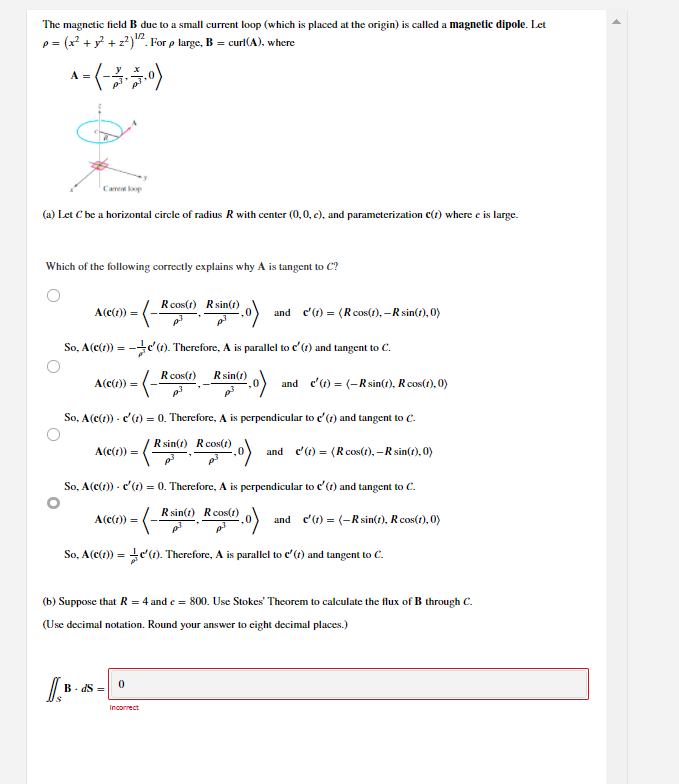The magnetic field B duc to a small current loop (which is placed at the origin) is called a magnetic dipole. Let p= (x² + y² + z?)". For p large, B = curl(A), where A = Care p (a) Let C be a horizontal circle of radius R with center (0,0, c), and parameterization c() where e is large. Which of the following correctly explains why A is tangent to C? Rcos(t) Rsin(1) A(c(1)) = and e) = (Rcos(1), – R sin(1), 0) So, A(c(?)) = -e'1). Therefore, A is parallel to e'(1) and tangent to C. R cos(t) Rsin(t) A(c(1)) = and e') = (-R sin(), R cos(), 0) So, A(c(1)) - e'(1) = 0. Therefore, A is perpendicular to e'(1) and tangent to C. 소 R sin(t) Rcos(t) and e') = (Rcos(), –R sin(o), 0) A(c(1)) = So, A(c(t)) · e'(1) = 0. Therefore, A is perpendicular to e'(1) and tangent to C. R sin(t) Rcos(t) A(ct) - and e) = (-Rsin(), R cos(1), 0) So, A(c(1)) = ¿e'(1). Therefore, A is parallel to e'() and tangent to C. (b) Suppose that R = 4 and e = 800. Use Stokes Theorem to calculate the flux of B through C. (Use decimal notation. Round your answer to eight decimal places.) B. dS = Incorrect
The magnetic field B duc to a small current loop (which is placed at the origin) is called a magnetic dipole. Let p= (x² + y² + z?)". For p large, B = curl(A), where A = Care p (a) Let C be a horizontal circle of radius R with center (0,0, c), and parameterization c() where e is large. Which of the following correctly explains why A is tangent to C? Rcos(t) Rsin(1) A(c(1)) = and e) = (Rcos(1), – R sin(1), 0) So, A(c(?)) = -e'1). Therefore, A is parallel to e'(1) and tangent to C. R cos(t) Rsin(t) A(c(1)) = and e') = (-R sin(), R cos(), 0) So, A(c(1)) - e'(1) = 0. Therefore, A is perpendicular to e'(1) and tangent to C. 소 R sin(t) Rcos(t) and e') = (Rcos(), –R sin(o), 0) A(c(1)) = So, A(c(t)) · e'(1) = 0. Therefore, A is perpendicular to e'(1) and tangent to C. R sin(t) Rcos(t) A(ct) - and e) = (-Rsin(), R cos(1), 0) So, A(c(1)) = ¿e'(1). Therefore, A is parallel to e'() and tangent to C. (b) Suppose that R = 4 and e = 800. Use Stokes Theorem to calculate the flux of B through C. (Use decimal notation. Round your answer to eight decimal places.) B. dS = Incorrect
Related questions
Question
17.1 - #10

Transcribed Image Text:The magnetic field B due to a small current loop (which is placed at the origin) is called a magnetic dipole. Let
p = (x +y +z?)". For p large, B = curl(A), where
1/2
A =
Care kop
(a) Let C be a horizontal circle of radius R with center (0,0, c), and parameterization c(r) where e is large.
Which of the following correctly explains why A is tangent to C?
Rcos(t) Rsin(t)
A(c(1)) =
and e'(1) = (R cos(), – R sin(t), 0)
So, A(c(1)) = -c't). Therefore, A is parallel to c'(1) and tangent to C.
Rcos(t)
Rsin(1)
A(c(1)) =
and e'(1) = (-R sin(t), R cos(1), 0)
So, A(c(1)) - c'(1) = 0. Therefore, A is perpendicular to e'(1) and tangent to C.
Rsin(t) Rcos(t)
A(c(1)) =
and e'(1) = (R cos(1), –R sin(t), 0)
So, A(c(1)) - c'(1) = 0. Therefore, A is perpendicular to e'(t) and tangent to C.
Rsin(t) Rcos(1)
A(c(1)) =
and c) = (-Rsin(), R cos(1), 0)
So, A(c(t)) = e'(1). Therefore, A is parallel to c'(?) and tangent to C.
%3D
(b) Suppose that R = 4 and e = 800. Use Stokes' Theorem to calculate the flux of B through C.
(Use decimal notation. Round your answer to eight decimal places.)
B- dS =
Incorrect
Expert Solution
This question has been solved!
Explore an expertly crafted, step-by-step solution for a thorough understanding of key concepts.
This is a popular solution!
Trending now
This is a popular solution!
Step by step
Solved in 6 steps
